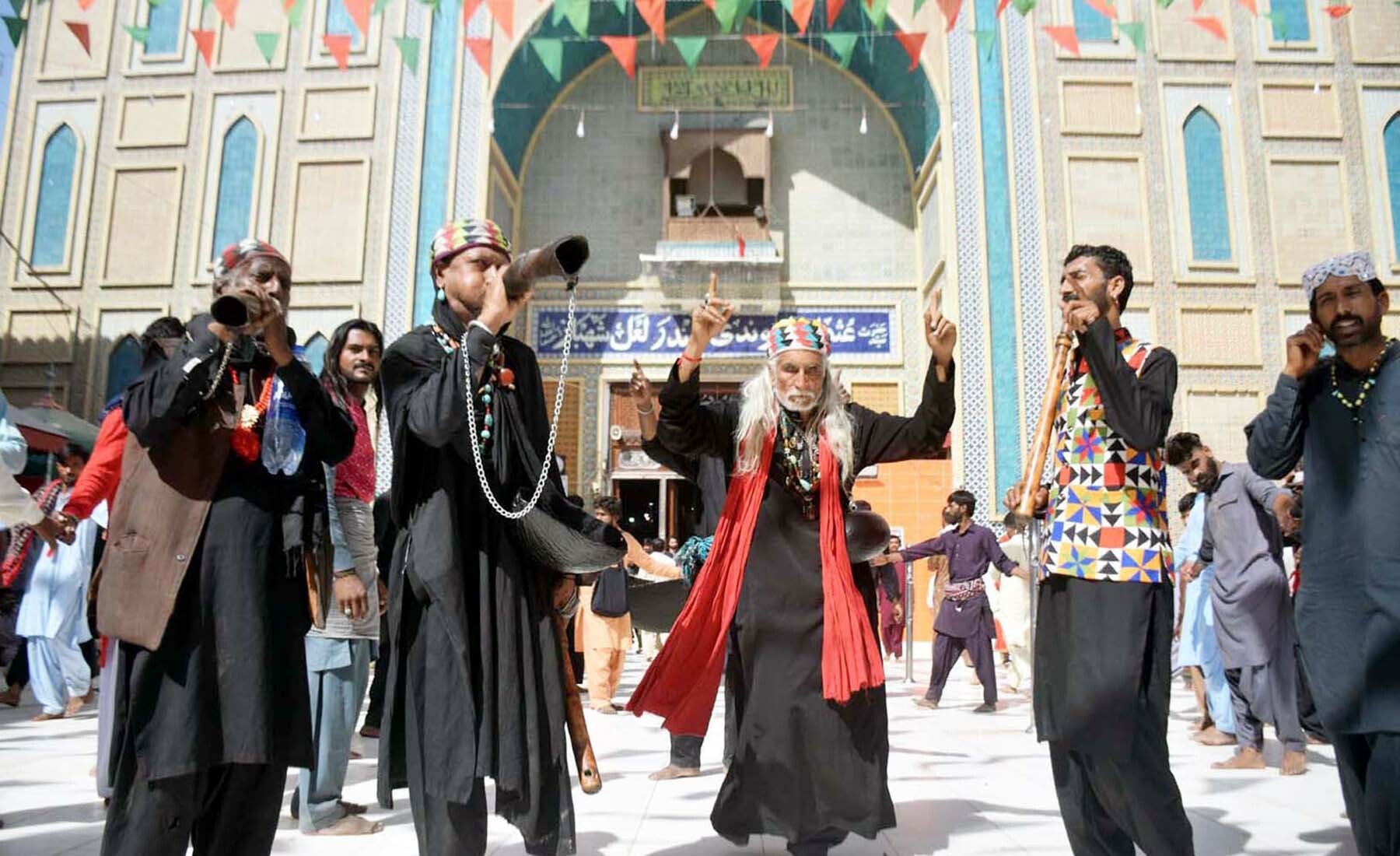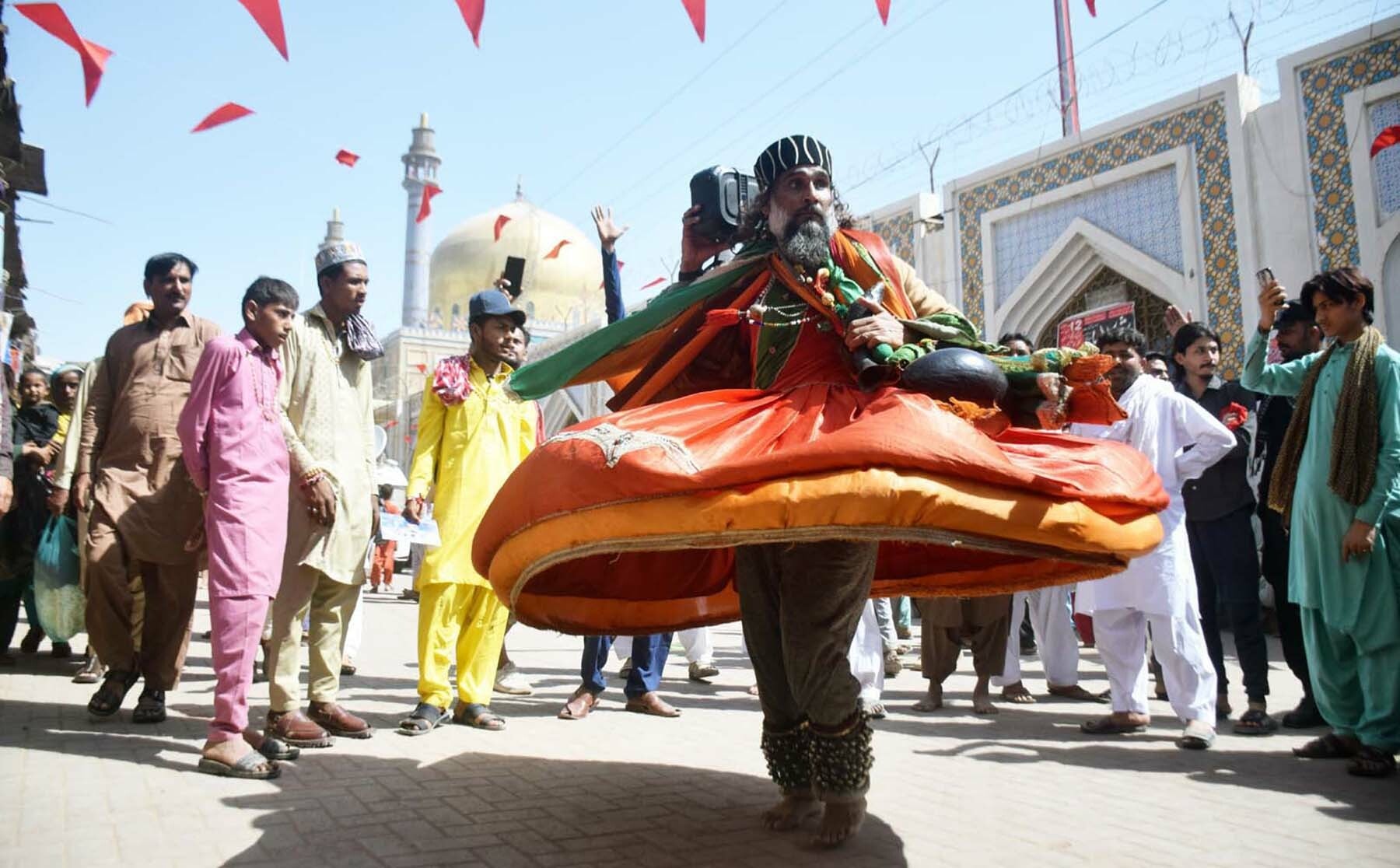In pictures: Without spectre of Covid-19, full-scale celebrations resume at Lal Shahbaz Qalandar's urs
Malik Anwar, a sexagenarian, feels elated to be part of full-scale celebrations of Qalandar Lal Shahbaz’s urs — taking place again after two years — thanks to the federal government having lifted all pandemic-related restrictions on gathering of people at shrines.
“I am just happy to be here again to see full-scale urs celebrations take place this year,” says Anwar, who is a resident of Punjab’s Rawalpindi district.
Urs of Hazrat Usman Marwandi, also known by his spiritual title Qalandar Lal Shahbaz, attracts millions from across Pakistan — mainly from Punjab — and other parts of the world.
During the two years of restrictions, Anwar did not give up visiting the shrine out of his reverence for the saint.

In 2020 and 2021, a limited number of devotees and officials were allowed to get together inside and outside the shrine with strict adherence to Covid-19 protocols. The traditional and religious rituals were also scaled down to only dhamal (devotional dance), rendition and recitals by small groups of devotees.
The restrictions on celebrations also led to clashes last year when hundreds of devotees, mostly from outside of Sindh, tried to force their way into the shrine. In the resulting violence, scores of devotees and seven policemen were injured.
“It’s just heartening to see devotees converging at the shrine, and staging dhamal in the courtyard without any fear or restrictions. Business is taking off again in Sehwan and the families are paying their respect to Lal,” said Anwar, quick to attribute his devotion, love and respect for Qalandar to his prayers that he said had been answered at the sacred place.

'Here to serve people'
Lahore resident Sibtain Naqvi — who originally hails from Multan, called the land of Sufis — echoed Anwar's sentiments.
The 39-year-old has taken it upon himself to serve devotees of Qalandar Lal Shahbaz. “I do it just to host people well as they show their reverence for Qalandar. I value their respect for Lal greatly,” he said
It has been Naqvi's routine for the last 15 years to serve langar (food) among devotees thrice a day — breakfast, lunch and dinner. The niaz (food served in the name of God) is distributed among around 200 people.
Every year, he reaches Sehwan a couple of days before Qalandar’s urs.

Naqvi's menu comprises halwa puri for breakfast, mutton biryani for lunch and in dinner the devotees devour qorma. “A cook accompanies me, while goats are purchased from Sehwan’s market and rest of the commodities are stocked before urs begin.”
Naqvi owns land in Sehwan Sharif — located in Makrani Para in the surroundings of the shrine — which he uses during the three days. “This time I am returning to Lahore early after performing my naukri (serving devotees),” he said.
Celebrations at the shrine
Sehwan — a small town around 130km northwest of Hyderabad on the right bank of Indus River — is witnessing brisk activities this year.
Shopkeepers in Sehwan have decorated their shops — an annual practice before the commencement of urs. Visitors remain busy in shopping, some purchasing pictures of holy personalities that were sold in the narrow streets behind Qalandar's shrine.
Men and women full of energy thronged the shrine while devotees performed dhamal exuberantly at Qalandar's urs.

His devotees are usually dressed in red-coloured frock-style attire that remains their hallmark. They perform dhamal at fixed timings in the shrine’s courtyard, also known as dhamal court, twirling in trance for several minutes.
Urs of a spiritual personality — held during three days of any specific lunar month that marks the passing away of a saint — is a mega event for people mainly belonging to the Barelvi school of thought. Although the day otherwise marks the saint's date of death, it is considered a meeting between devotees’ murshid (spiritual guide) and God. That is why disciples celebrate this occasion with great jubilation, believing that the saint remains their only contact between them and God.

People with different religious beliefs visit the shrine throughout the year, with their numbers swelling around urs celebrations. Bare-footed men and women of all ages keep thronging Qalandar’s abode as the temperature gradually starts soaring in March.
Many perform dhamal in groups outside the dome while others struggle to enter the shrine with ‘bolo bolo mera sohna Lal Qalandar mast” cries. Others keep producing sounds of horns from a seashell-like object inside the shrine.

“I have inherited this affection for Qalandar as a legacy from my ancestors,” shared a young woman named Gul Zareen, who arrived from Multan. She will return to Punjab after paying her respects. “To be here every year gives me solace,” she said.
Qalandar Lal Shahbaz, it is said, used to perform dhamal as a tribute to the martyrs of Karbala when he felt immersed in their love.
Commemorating the saint's practice, men sporting beards, resplendent in their red-coloured frocks and with twinkling anklets, perform dhamal in a trance. For them, having long hair and a begging bowl in hand is a way of showing deep affection.
Some beat their chest in the courtyard in memory of Hazrat Imam Hussain, the maternal grandson of Holy Prophet Muhammad (PBUH), women present nauhas (elegies) inside, while others only sit in awe of Qalandar whose shrine is a replica of Imam Ali Raza's shrine in Mashhad, Iran.

According to the spiritual order relating to Qalandar, those intending to pay their respects at the shrine have to first visit the tomb of Qalandar’s beloved — Sakhi Bodla Bahar. Bahar was the most trustworthy servant of Qalandar and many legends are attributed to him.
The shrine's staff closes the inner sanctum for prescheduled formal opening ceremony on the morning of 18th Shabaan — the day urs begins. And when the doors open, one feels influenced by the spellbinding aura of mysticism upon entering the shrine.

Lost festivities
However, all of this was lost when the coronavirus descended on Sehwan, as it did on the rest of the world.
Over the last two years, the sight of the deserted shrine felt painful to many.
An eerie silence prevailed around the shrine. All passages leading to it remained completely shut.
The shrine was closed mid-March 2020 as a precautionary measure by the Sindh government , followed by a province-wide lockdown on March 23.


There were no devotees to chant bolo bolo mera sohna Lal Qalandar mast as silence hung heavy in the air, disturbed only by the cooing and fluttering of pigeons around the dome and right above the beautiful dark brown wooden frame called ‘katehra’ or zari in Persian.
Shops were also closed back then. Financial losses to businesses were undoubtedly colossal as the annual feature of urs generates millions in revenue in Sehwan in a few days; people spend plenty of money in alms and langar during their stay, which boosts the local economy and residents rent out their properties to visitors to make additional income.
But the festivities, after a two-year gap, have again returned to Sehwan. And Malik Anwar wishes this stays.

Header image: A devotee performs dhamal at Lal Shahbaz Qalandar's urs in Sehwan.


